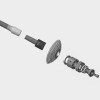Soft tissue sarcomas: types of surgery
- Home
- Sarcomas surgery
- Soft tissues sarcomas
- Soft tissue sarcomas: types of surgery
TYPES OF SOFT TISSUE SARCOMA SURGERY
Depending on the type of resection in soft tissue sarcomas, your surgery may be classified as
- Intralesional surgery: Excision of the tumour mass is performed by removing only a part of the tumour, leaving a variable amount of it.
- Marginal surgery: The plane of dissection passes through the pseudocapsule of the tumour. The fact of leaving the reactive area of the tumour in the surgical bed with its potential contamination by tumour cells, makes it an inadequate type of resection with a high probability of local recurrence.
- Wide surgery: It is performed when the complete exeresis of the tumour, its pseudocapsule and a variable amount of healthy tissue around the mass in all directions of the space is achieved. This amount of tissue is defined by the histological nature of the tissue. It can be a few millimetres in the case of an anatomical barrier such as the periosteum or fascia or a few centimetres in the case of adipose or muscular tissue.
- Radical surgery: Surgical resection is of interest to the entire compartment of the limb in which it is housed. It is performed on large sarcomas and in those cases where skip metastases are detected.
Local recurrence
We talk about local recurrence when the disease comes back in the same area where the tumour originally originated. This usually occurs when adequate margins have not been achieved during previous surgery.
Local recurrence is usually treated by extensive resection of the tumour followed by postoperative radiation therapy. If the previous surgery was very contaminating - for example intralesional surgery followed by a large hematoma - or involves more than one compartment, amputation is sometimes the only therapeutic option.
Sarcomas can recur at a distance and when this occurs the target organ is usually the lung. The lymphatic spread of these, although possible, is truly exceptional.
Reconstructive surgery
Sarcomas can reach considerable sizes, often above 20 cm. This fact sometimes forces to big demolition surgeries, with big muscular and tendon resections. In addition, it is not uncommon for vascular structures to be sacrificed, requiring reconstruction with vascular grafts.
In case of loss of an important nerve, reconstruction is more complex. Sciatic nerve loss is better tolerated for walking than femoral nerve loss, since quadriceps function is performed against gravity. Capanna and his group in Florence have described a technique for reconstruction of anterior thigh demolition surgeries in which the entire quadriceps had to be sacrificed. They perform a free graft of neurotic broad dorsal with nerve anastomosis to the femoral nerve, achieving voluntary muscle contractions in the grafted muscle.
If a hospital wishes to have a team specialized in limb-sparing surgery in cases of soft tissue sarcoma, the assistance of an orthopaedic surgeon who performs the demolition surgery respecting and understanding the functionality of the limb is essential. Such a surgeon will sometimes require the assistance of a fellow plastic surgeon with experience in microsurgery, allowing him to perform free grafts or muscle flaps when soft tissue coverage is a problem.
Dr. Óscar Tendero's team has an advanced plastic surgery team that performs high-level reconstructions, allowing him to speed up the indication for amputation to rare, truly extreme cases.
Contact Dr. Oscar Tendero in Mallorca and find out what services we can offer you in sarcoma surgery.
YOUR HEALTH FIRST

GEIS bone tumor meeting

Endo-exo integrated femoral prosthesis
CONSULT
Hospital Juaneda Miramar
Camí de la Vileta, 30
07011 Palma
971 280 000


